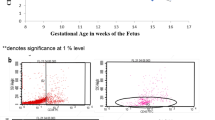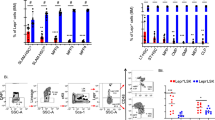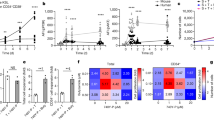Summary:
Adult mesenchymal stem cells (MSCs) have been suggested to decrease lymphocyte proliferation in vitro. We hypothesised that foetal MSCs (fMSCs) would have an immunosuppressive effect on allograft responses in vitro. Human MSCs were isolated and cultured from first-trimester foetal livers and characterised by flow cytometry. fMSC stained positive for CD29, CD44, CD166, CD105, SH-3 and SH-4, and negative for CD14, CD34 and CD45. When plated on adipogenic, chondrogenic and osteogenic media, fMSC differentiated into the respective cell lineage. Compared to adult MSC (aMSC), the proliferative capacity of fMSC was higher. Mitogen stimulation of PBL was inhibited by fMSC. The greatest inhibition (78%) was seen when 30 000 fMSCs were added to 150 000 lymphocytes stimulated by phytohaemagglutinin. Adult and fMSCs were added to mixed lymphocyte cultures (MLC) containing peripheral blood lymphocytes or foetal liver cells. Unlike aMSC, fMSCs did not inhibit MLC. fMSC could be culture-expanded several million folds with no loss of phenotype characteristics, which makes them ideal for ex vivo expansion. fMSC inhibit lymphocyte proliferation induced by mitogens, but not alloreactivity as measured by MLC.
This is a preview of subscription content, access via your institution
Access options
Subscribe to this journal
Receive 12 print issues and online access
$259.00 per year
only $21.58 per issue
Buy this article
- Purchase on Springer Link
- Instant access to full article PDF
Prices may be subject to local taxes which are calculated during checkout





Similar content being viewed by others
References
Caplan AI . Mesenchymal stem cells. J Orthop Res 1991; 9: 641–650.
Pittenger MF, Mackay AM, Beck SC et al. Multilineage potential of adult human mesenchymal stem cells. Science 1999; 284: 143–147.
Caplan AI . The mesengenic process. Clin Plast Surg 1994; 21: 429–435.
Erices A, Conget P, Minguell JJ . Mesenchymal progenitor cells in human umbilical cord blood. Br J Haematol 2000; 109: 235–242.
Campagnoli C, Roberts IA, Kumar S et al. Identification of mesenchymal stem/progenitor cells in human first-trimester fetal blood, liver, and bone marrow. Blood 2001; 98: 2396–2402.
Young HE, Steele TA, Bray RA et al. Human pluripotent and progenitor cells display cell surface cluster differentiation markers CD10, CD13, CD56, and MHC class-I. Proc Soc Exp Biol Med 1999, 221: 63–71.
Di Nicola M, Carlo-Stella C, Magni M et al. Human bone marrow stromal cells suppress T-lymphocyte proliferation induced by cellular or nonspecific mitogenic stimuli. Blood 2002; 99: 3838–3843.
Le Blanc K, Tammik C, Sundberg B et al. Mesenchymal stem cells inhibit and stimulate mixed lymphocyte cultures and mitogenic responses independently of the major histocompability complex. Scand J Immunol 2003; 57: 11–20.
Devine SM, Bartholomew AM, Mahmud N et al. Mesenchymal stem cells are capable of homing to the bone marrow of non-human primates following systemic infusion. Exp Hematol 2001; 29: 244–255.
Bartholomew A, Patil S, Mackay A et al. Baboon mesenchymal stem cells can be genetically modified to secrete human erythropoietin in vivo. Hum Gene Ther 2001; 12: 1527–1541.
Koc ON, Peters C, Aubourg P et al. Bone marrow-derived mesenchymal stem cells remain host-derived despite successful hematopoietic engraftment after allogeneic transplantation in patients with lysosomal and peroxisomal storage diseases. Exp Hematol 1999; 27: 1675–1681.
Mackenzie TC, Flake AW . Human mesenchymal stem cells persist, demonstrate site-specific multipotential differentiation, and are present in sites of wound healing and tissue regeneration after transplantation into fetal sheep. Blood Cells Mol Dis 2001; 27: 601–604.
Westgren M, Ek S, Bui TH et al. Establishment of a tissue bank for fetal stem cell transplantation. Acta Obstet Gynecol Scand 1994; 73: 385–388.
Lennon DP HS, Bruder SP, Jaiswal N et al. Human and animal mesenchymal progenitor cells from bone marrow: identification of serum for optimal selection and proliferation. In Vitro Cell Dev Biol 1996; 32: 602–611.
Prockop DJ . Marrow stromal cells as stem cells for nonhematopoietic tissues. Science 1997; 276: 71–74.
Berg B, Ringdén O . Correlation between relative responses in mixed lymphocyte culture, HLA- D and DR typing, and graft survival in renal transplantation. Transplantation 1982; 33: 291–297.
Greaves M, Janossy G, Doenhoff M . Selective triggering of human T and B lymphocytes in vitro by polyclonal mitogens. J Exp Med 1974; 140: 1–18.
Ringdén O, Rynnel-Dagöö B . Activation of human B and T lymphocytes by protein A of Staphylococcus aureus. Eur J Immunol 1978; 8: 47–52.
Conget PA, Minguell JJ . Phenotypical and functional properties of human bone marrow mesenchymal progenitor cells. J Cell Physiol 1999; 181: 67–73.
Majumdar MK, Thiede MA, Mosca JD et al. Phenotypic and functional comparison of cultures of marrow-derived mesenchymal stem cells (MSCs) and stromal cells. J Cell Physiol 1998; 176: 57–66.
Krampera M, Glennie S, Dyson J et al. Bone marrow mesenchymal stem cells inhibit the response of naive and memory antigen-specific T cells to their cognate peptide. Blood 2003; (in press).
Bartholomew A, Sturgeon C, Siatskas M et al. Mesenchymal stem cells suppress lymphocyte proliferation in vitro and prolong skin graft survival in vivo. Exp Hematol 2002; 30: 42–48.
Lun MT, Cochi S, Fioravanti D et al. Effect of cyclosporin A on B cell maturation and differentiation. Drugs Exp Clin Res 1991; 17: 493–500.
Lindton B, Markling L, Ringdén O et al. Mixed lymphocyte culture of human fetal liver cells. Fetal Diagn Ther 2000; 15: 71–78.
Hobbs JR, Hugh-Jones K, Barrett AJ et al. Reversal of clinical features of Hurler's disease and biochemical improvement after treatment by bone-marrow transplantation. Lancet 1981; 2: 709–712.
Hobbs JR . Bone marrow transplantation for inborn errors. Lancet 1981; 2: 735–739.
Parkman R, Rappeport J, Geha R et al. Complete correction of the Wiskott–Aldrich syndrome by allogeneic bone-marrow transplantation. N Engl J Med 1978; 298: 921–927.
Ringdén O, Groth CG, Erikson A et al. Ten years' experience of bone marrow transplantation for Gaucher disease. Transplantation 1995; 59: 864–870.
Hoogerbrugge PM, Brouwer OF, Bordigoni P et al. Allogeneic bone marrow transplantation for lysosomal storage diseases. The European Group for Bone Marrow Transplantation. Lancet 1995; 345: 1398–1402.
Touraine J, Raudrant D, Laplace S et al. Intrauterine transplantation for immunodeficiencies and hemoglobinopathies in man. In: Ringdén O, Hobbs J, Steward C (eds). Correction of Genetic Diseases by Transplantation 1997. COGENT: London, 1997, pp 163–173.
Westgren M, Ringden O, Bartmann P et al. Prenatal T-cell reconstitution after in utero transplantation with fetal liver cells in a patient with X-linked severe combined immunodeficiency. Am J Obstet Gynecol 2002; 187: 475–482.
Horwitz EM, Gordon PL, Koo WK et al. Isolated allogeneic bone marrow-derived mesenchymal cells engraft and stimulate growth in children with osteogenesis imperfecta: Implications for cell therapy of bone. Proc Natl Acad Sci USA 2002; 99: 8932–8937.
Acknowledgements
We thank Lola Markling for organising and distributing the foetal liver tissues and Osiris Therapeutics for providing antibodies.
This study was supported by grants from the Swedish Cancer Society (0070-B99-13XAC), The Children's Cancer Foundation (1997/073), the Swedish Medical Research Council (K2000-06X-05971-20A, K2001-06X11231-07B), the Tobias Foundation, the Stockholm Cancer Society, the FRF Foundation and by the European Commission Biomed 2 Programme (Eurofoetus project).
Author information
Authors and Affiliations
Rights and permissions
About this article
Cite this article
Götherström, C., Ringdén, O., Westgren, M. et al. Immunomodulatory effects of human foetal liver-derived mesenchymal stem cells. Bone Marrow Transplant 32, 265–272 (2003). https://doi.org/10.1038/sj.bmt.1704111
Received:
Accepted:
Published:
Issue Date:
DOI: https://doi.org/10.1038/sj.bmt.1704111
Keywords
This article is cited by
-
Multiple Dimensions of using Mesenchymal Stem Cells for Treating Liver Diseases: From Bench to Beside
Stem Cell Reviews and Reports (2023)
-
Insights of CRISPR-Cas systems in stem cells: progress in regenerative medicine
Molecular Biology Reports (2022)
-
Human fetal liver MSCs are more effective than adult bone marrow MSCs for their immunosuppressive, immunomodulatory, and Foxp3+ T reg induction capacity
Stem Cell Research & Therapy (2021)
-
Corneal Repair with Adhesive Cell Sheets of Fetal Cartilage-Derived Stem Cells
Tissue Engineering and Regenerative Medicine (2021)
-
Engineered cartilage utilizing fetal cartilage-derived progenitor cells for cartilage repair
Scientific Reports (2020)



